Hand of Fate 2 is a bit of an odd game. While it does everything a sequel generally should such as: improves the gameplay, has more options, new enemies and so on. I oddly didn’t have as much fun playing it, as I did the first one. Part of that, is on the technical side. However, part of that is also the novel nature of the first game has worn off. I found a lot of the new things may really annoy players instead.
Hand of Fate 2 Review
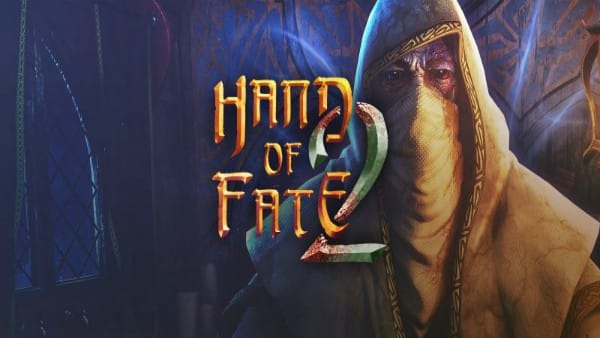
Title: Hand of Fate 2
Platform: PS4, PC [Reviewed]
Genre: Board Game Action
Developer: Defiant Development
Publisher: Defiant Development
Players: 1
Release Date: November 7, 2017
Price: $29.99
Starting Out
Hand of Fate 2 is a hybrid game, part board game and part rogue-like/dungeon crawler. At the start of the game, you create a character, which is a nice switch from the first game. After that, you are slowly introduced to the mechanics of the game.
The Board Game

The board game aspect of Hand of Fate 2 is still its strongest element. Although it’s been changed some for this game. In the first one, you went through levels almost sequentially. Unlocking harder levels through progression.
In this game, the progression is similar, to an extent. However, it’s a more open system. There are about 20 levels, which correspond to various tarot card names. Instead of the same general formula of the first game, each level has its own unique hook. One might involve you needing to get a set number of blessings before hitting the final area. While another might involve defending a farmer throughout an entire level. Some of these levels have not only a main goal, but also a bonus goal as well. Completing the bonus goal also unlocks additional cards for use in future levels.
The Start of a Stage
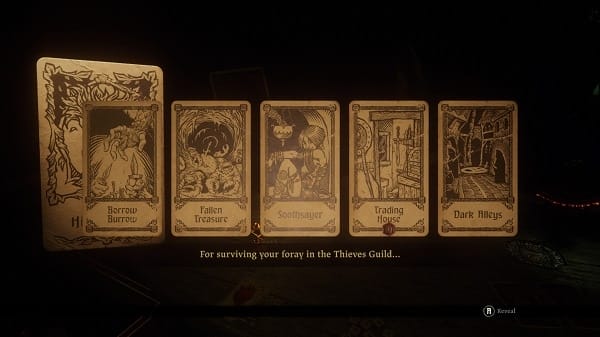
At the start of a level, you are tasked with building a deck of cards. The dealer then builds the primary level (deck) with his cards. In Hand of Fate 2, you carry even more responsibility. Since you also select a follower (if you want), starting equipment, the equipment that shows up in a level, and enemy encounters (both good and bad) as well. A lot of the time, encounters are beneficial. For example, a store may appear, which you can buy equipment from, or use to earn more gold. Some negative encounters can also be useful too. Especially since they may come with a token that unlocks new cards if you manage to complete them.
Board Game Play
Depending on the card layout, the game may progress in a linear, or open-ended manner. You move your character one space, as long as there are other cards available on the playing surface. Landing on a card activates it, which then begins an encounter. Encounters are the quests of the game.
Encounters
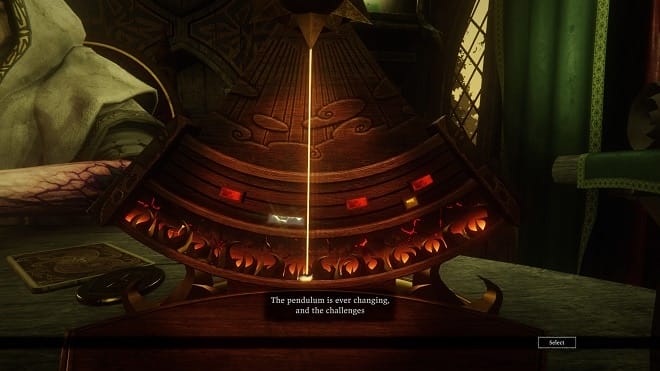
Typically, encounters breakdown into a few general types: fighting, text adventure, chance game, or other. Here’s an idea of each:
Fighting: you and your companion (if you use one) fight against various enemy units or monsters.
Text adventure: these encounters usually lead into chance games, but they involve you having to make choices, or pick a side.
Chance game: these encounters are basically four (or five) card Monte. This starts a process of situations. Where you roll dice to get a certain number. Stop a beam of light on an area as it swings on a pendulum, and finally a wheel of fortune where you attempt to stop on a good outcome. By far, the four card Monte is the game you’ll see the most. Having to find a “success” (or huge success) card, amid shuffling failure (or huge failure) cards.
Lastly there are the “other” encounters. These are mostly good encounters. For example, you may buy equipment or food, restore your health, get a blessing (beneficial spell), or earn gold. These can also lead into chance encounters, but there is less of a penalty If you lose.
Rewards
Rewards from encounters range from the above-listed, equipment, money, food, upgraded health, and so on. However, some encounters (usually text adventure ones) drop bronze tokens if you complete them. Once you complete a level, the token unlocks, which gives you more cards (encounters or equipment) to play with in future levels.
Also, some encounters are more like sidestories and may be linked. One of the earliest ones is with your companion The Bard. He has a multi-encounter side quest, where it takes three or four sequential successful encounters to fully unlock his story. Once unlocked, he gets a new title and an upgraded skill.
The Board Game Continued

The board game part eventually culminates into a boss battle. These aren’t too challenging, but they can be annoying depending on the level’s restrictions. For example, in one stage you are cursed with low health and can’t heal by food, which is just brutal.
The key to actually winning the board game is in managing your resources correctly. Each step on a new card costs one food. Eating restores some health. However, if you don’t have food, you will eventually starve. Starving starts draining your life rather quickly. You can buy more food at your camp, or get more from various “good” encounters. Although you can also lose some through bad encounters as well. Managing your food resource is probably the biggest thing to worry about in the entire board game.
The Fighting

Fighting is a lot like the first game. You have a basic attack, a “bash” attack, (which whittles down armor), a roll, companion abilities, executions, and weapon abilities. Weapon skills are only usable once you have a hit combo going. But, if you get hit, it resets back to zero. Finally, you can do a Batman-style counter when enemies attack. A green arrow/outline shows when the counter window is active. Then a red one appears when an enemy does an attack that can’t be countered.
Fighting feels somewhat better than the first game. However, it is by no means “great.” Mainly because it feels slightly swimmy in spots, like you are fighting in molasses. Another issue is that if there are multiple enemies attacking you, the game has a real problem with letting you counter in quick succession.
New Stuff
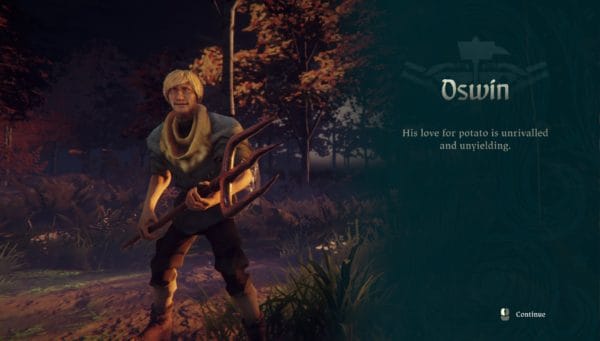
On the surface there is little difference between Hand of Fate 1 and 2. But there are some big ones. Firstly, you have a selectable companion now, which is incredibly useful both on the board game and in battle. There is the “camp” option. Where you can rest on a card after you’re done with it. Thus allowing you to buy some extra food and equipment, if available. Levels are designed much better than in the first game as well. Now, they actually carry objectives for you to complete as you go through them. It’s nothing earth-shattering, but it does make Hand of Fate 2 a richer experience.
One Major Problem
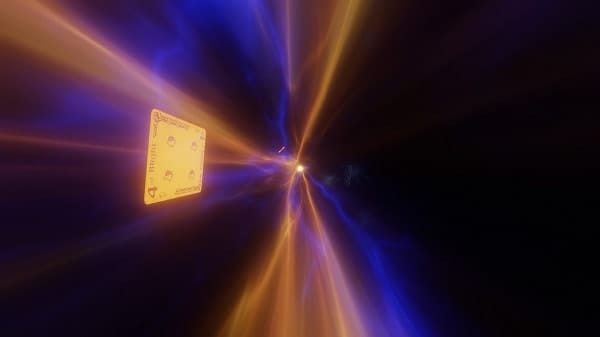
However, there is a rather large “but” here. The technical aspect of the game is kind of gnarly. Particularly on Playstation 4. The board game aspect is relatively decent, but the fighting is where it can slow down badly. Especially, if there are more than four characters on screen. The most noticeable thing is the transitions between the board game and fighting engine. The game does this very cool tunnel effect where the cards are sliding down this tube. It sounds neat, and looks neat, until you see it chugging like crazy.
Pros:
- It’s still fun to mix a board game with an action game
- The new levels have very different goals and paths for you to take
- Companions and the camp help ease in players to the game.
Cons:
- Combat still isn’t up to par
- Weird technical issues can break up the flow of the game
- Some stages require multiple playthroughs, since you won’t have required cards at first
Final Rating
Overall Score: 8 out of 10. Although it has a few small problems, Hand of Fate 2 is an overall better version of the first game. Combat is a tad better. While the board game aspect has more choices, and the two sides still mesh together in interesting ways. Not to mention, on PC the technical issues are much less of an issue. If you enjoyed the first game, or were a bit curious about it previously, this is the edition to purchase.
For the sake of transparency, the publisher (Defiant Development) provided a digital copy for review purposes.
